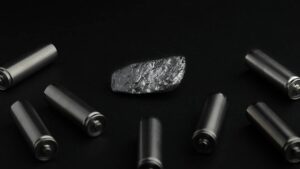Graphite market ripe for lithium style boom as Renascor closes in on development of Siviour mine in South Australia

Is the time ripe for graphite to follow lithium’s rocket ride to the moon? Pic via Getty Images.
While battery makers, miners and car manufacturers continue to warn of supply risks in lithium, nickel, copper and rare earths, disruptions of equal or greater magnitude in other key commodities threaten to hold back the EV revolution.
One is graphite, the core component in the anode of a lithium-ion battery.
Now predominantly a battery mineral after years linked to the steel supply chain, subdued prices have prevented new producers outside China from entering the market.
Major players now warn signs of tightness are beginning to emerge.
While China produces two-thirds of the world’s natural flake graphite, it has incredibly become a net importer of material, desperate to service the midstream purified graphite market almost entirely centred in the Asian economic powerhouse.
With prices up around 60% from ~US$500/t to a far more attractive ~US$800/t for 94% flake graphite in recent years, it has near term developers like Renascor Resources (ASX:RNU) managing director David Christensen licking their lips about the future for the commodity.
In his eyes, the chief of the South Australian integrated graphite company sees similar conditions that contributed to the supply shortage and 700% run up in lithium raw material prices last year duplicating in the graphite market.
“As more lithium-ion batteries have been built, the proportion of graphite going into the lithium ion sector has increased. It’s now predominantly a battery mineral,” Christensen told Stockhead.
“And because of that it has the potential to go up even more where lithium, for instance, made this pivot point four or five years ago.
“China, for instance, is the only midstream processor of graphite, it’s also a producer of two thirds of the world’s graphite at the mine.
“But what’s happened with China is now they’re importing graphite from abroad and the reason they’re importing it is for the lithium ion battery sector, because they need more because they control the midstream.
“So the graphite prices are a lot higher now and it’s in those lithium-ion battery segments. And that’s where we think it’s likely to continue to increase.”
Supply chain reaction
Much like lithium, Christensen says, the biggest impediment to increasing graphite supply for batteries is not at the processing level.
It is in the dearth of new mines being funded and developed to produce the raw material.
“We see those prices only increasing,” he said.
“To us it looks very similar to lithium, where you had lithium mines that were starting three or four years ago, and they were looking at prices and saying, geez this looks okay we could probably get some financing and get this going.
“But then the price increased, in the case of battery grade lithium carbonate, by as much as 700%.
“I’m not saying that graphite prices have to increase by that much, but they need to increase by more because it’s not just Renascor Resources that needs to be incentivised to get into production.”
“You need 50-odd new mines over the next five years to meet the demand projections for anode. And these are real factories that have been built to produce anodes that have the risk of not having enough material.”
Renascor’s Siviour project in South Australia ranks as one of a handful of graphite mines of scale globally that can be developed in advance of the major supply shortages projected over the coming decade.
The ASX-listed company, a recently crowned ASX 300 entity which has seen its share price rise 20 times over since its penny stock days in late 2020, already has PEPR approval for the first stage of Siviour.
It represents the second largest reserve of graphite the world over and largest outside Africa at 51.5Myt at 7.4% total graphitic content for 3.8Mt of contained graphite – enough to back a multigenerational 40 plus year mine life.
Leading candidate
What makes Renascor different in the graphite market is how advanced it is, with a project that is as close as just about any in the next generation to being development ready.
The desperate need for graphite in the global supply chain has Renascor looking to start its upstream first stage as soon as possible.
Renascor became the first company to receive an Export Finance Australia loan from the Australian Government’s $2 billion CriticaI Minerals Facility in February last year, claiming a conditional $185 million loan from Canberra to support the construction of Siviour.
If it can complete front end engineering design, convert non-binding offtakes to binding and sew up its financing package this year construction could begin on the open cut mine and concentrator in 2023, with commissioning to start in the back end of 2024.
A second stage taking the firm midstream as a producer of uncoated spheronised purified graphite would follow thereafter.
That would make Renascor a direct supplier of graphite products to anode makers, and one of the few outside of China, potentially qualifying American EV makers who use anode made from its products for tax credits under the Biden Administration’s Inflation Reduction Act.
“What makes our company valuable is two things. The deposit itself is big, one huge ore body, and we’re in South Australia,” Christensen said.
“So that allows us then to vertically integrate and get a better margin by going downstream and not only get a better margin by going downstream, but then to sell it directly into the lithium ion battery space instead of selling it to midstream processors in China.
“Because they have that midstream processing, they have a monopoly on it, they do all of it.
“More broadly, just in terms of the resource, I’d say there’s probably a half dozen very good deposits that can produce at low cost, at scale. We have one of them, the other ones tend to be in Africa.
“So in a nutshell, and a lot of the African projects that you’re familiar with are very good deposits, we think we stack up quite well at the concentrate side, the flake graphite, but then we have the advantage of going downstream because we’re not only in a secure jurisdiction, we’re in an industrial jurisdiction.”
90 new projects
Industry consulting firm Benchmark Minerals Intelligence said last year that the graphite industry would need 54 new mines by the end of the decade to satisfy projected demand growth from the lithium ion battery sector.
As many as 90 graphite projects of any kind of Siviour’s size will be necessary over the next seven years.
“Those kinds of numbers are going to be really difficult to meet and it has the potential to slow down some of the EV growth, right. And it’ll be interesting to see what happens,” Christensen says.
“At US$800 a tonne I think a lot of projects, once you include all in costs and financing, they’re going to be more marginal.
“But as the price goes up, it’s going to incentivise new people to come in and eventually you’ll reach an equilibrium, but it’s likely to take a significant amount of time.”
That means a period of higher prices will likely be needed to ensure the market can sustain itself and handle demand growth.
Even with synthetic graphite presenting as a potential competitor, though one which fails against natural on costs, energy efficiency and ESG metrics, Christensen says the feedback from customers is they are after more of both synthetic and natural graphite to fill order books.
According to a 2020 project study Siviour will produce 28,000tpa of purified spheronised graphite in its first stage, but already has non-binding offtake agreements for 60,000tpa from South Korean industrial giant POSCO, Zeto an Minguang New Material out of China and Hanwa Corporation from Japan.
POSCO is one of Australia’s largest individual trading partners and played a key role in the development of our world-leading iron ore and lithium industries. In the latter it was an early funder and offtaker for ASX 50 lithium giant Pilbara Minerals (ASX:PLS), with whom the conglomerate is now building a hydroxide processing plant in its home country.
Almost all anode manufacturing globally is done in China, Japan and Korea.
“That’ll change in a number of years as more anode capacity grows outside of those regions, but none of the top 50 anode makers in the world have publicly announced plans to move outside of those regions,” Christensen said.
“POSCO Chemical is currently dependent on China for that midstream.
“The fact that we’re not in China probably gives them a degree of supply diversity, which is important, especially because their competitors are in China too.
“Their Chinese competitors are naturally able to access the Chinese markets more readily than they can. And then the other issue is … the Inflation Reduction Act in the United States has now put a premium on graphite flake that comes from either the US or a free trade country, of which Australia is one.
“We think things like that should make us particularly appealing to groups outside of China, (which) is Japan and Korea at this stage.”
Index mover
Renascor’s move into the ASX 300 in this month’s March index rebalance, as well as peer Syrah’s transition to the ASX 200, is a sign of graphite’s emergence in the eyes of investors.
“People have seen what’s happened in lithium, and in lithium, I think some of the investment advice on lithium is trying to get exposure to the explorers,” Christensen said.
“But there’s a larger degree of risk associated with exploration and, in graphite, many investors, including large institutions, are becoming attracted to advanced development graphite projects, because they see that as being a lower risk.”
In the graphite market many of the early mover companies who could benefit from a similar boom are at a similar stage to where Pilbara and Galaxy Resources (ASX:GXY) were a few years ago.
“For an investor who is attracted to the potential for increased graphite prices, advanced graphite developers like us, and other near-term producers offer an especially attractive investment case,” Christensen said.
“The situation with graphite has some direct parallels to where lithium was some years ago, where in just a few short years companies like Pilbara Minerals have grown enormously and is now one of Australia’s largest companies.
“And Pilbara was by no means a first mover – but they had an early mover advantage.
“They were able to leverage that into what’s become really a dominant position in the market right now. Graphite again has that potential.
“Whether it’s by 700% in a year really doesn’t matter, you just need significantly more material, that can only cause the price to go up.
“Hence producers who can do it are going to have the potential to benefit from it.”
This article was developed in collaboration with Renascor Resources, a Stockhead advertiser at the time of publishing.
This article does not constitute financial product advice. You should consider obtaining independent advice before making any financial decisions.
Related Topics

UNLOCK INSIGHTS
Discover the untold stories of emerging ASX stocks.
Daily news and expert analysis, it's free to subscribe.
By proceeding, you confirm you understand that we handle personal information in accordance with our Privacy Policy.








